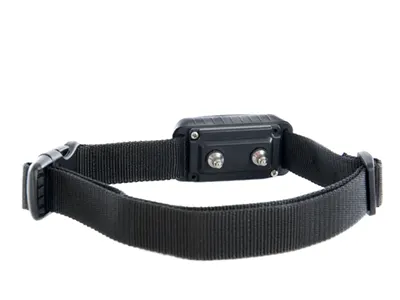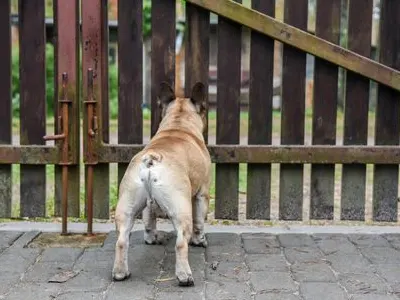Nobody likes that sinking feeling of realizing your dog has run away, but it happens to many of us.
Whether you have a privacy fence, a chain-link fence, or an invisible fence, some dogs have a knack for escaping.
What do I do if my dog runs through my invisible fence?
Obviously, the first step is to track down your dog, make sure they are safe, and get them back in the yard. After that, how do you keep this from happening again?
We’ll tell you what to do if your dog runs through the invisible fence, and steps you can take to keep it from happening again.
What Do I Do If My Dog Runs Through My Invisible Fence?
If your dog runs through an invisible fence, first try to locate the dog and bring it home.
Take the collar off before crossing the boundary to avoid shocking the dog. Give cuddles, praise, and treats for returning home.
Check the transmitter for power supply, make sure the boundary line is intact (test using the collar), make sure collar batteries are fresh, and that your fence is placed in a closed loop.
If everything is functioning, then increase correction measures. You may also want to check to see if your fence and collar are on the same frequency.
Increase the correction level on the collar by one number, and ensure you know where it is set.
Increase the boundary width setting or dial on the transmitter unit so the dog can’t get so close and run through.
Replace the boundary flags and revisit training with the dog. Provide many indestructible toys and treat toys to keep the dog happily busy during the time in the yard.
This will help cut down on boredom.
Read our related article, Is Invisible Fence Worth It? It could be that Invisible Fence isn’t right for your dog.
How To Find Your Runaway Dog

If your dog escaped the yard, and you are not sure where he went, your first step will be to find him.
Check around your neighborhood, and be sure to ask people if they’ve seen him.
It’s helpful to keep a recent photo of your dog in your phone or wallet so you can show people when you ask if they’ve seen him.
If your dog is happily enjoying his freedom, you may have a tough time catching him.
Never attempt to chase down your dog, threaten your dog, or sound angry when you call.
Studies show that your dog distrusts you when you lose your temper. If you are angry, do your best to conceal your agitation because your dog will run farther away from you.
Always have a leash and extra collar in hand, although you may want to keep those hidden behind your back when you approach your dog so you don’t alarm him.
We also recommend having some treats or a favorite toy on hand to tempt him to come to you.
If your dog does come to you, resist the urge to scold him for running through his invisible fence.
Praise him and give lots of love and cuddles for coming to you so that if this ever happens again, your dog will remember that coming to you equals rewards.
Worst case scenario, if you can’t find your dog right away, there are steps and precautions you can take to track him down.
Put up posters around the neighborhood with pictures of your dog and your phone number. Post on social media asking people to keep an eye out for your pup.
You can also ask local animal shelters, humane societies, and vets to see if someone has brought in your dog.
Most have websites or social media sites where you can see photos of found animals.
Finally, think about offering a small reward for the safe return of your pup. This might prompt some people to go out of their way to help reunite you with your dog.
Read More: Can a Dog Jump Over an Invisible Fence? Maybe! Here’s what you need to know to prevent escapes.
Figure Out Why Your Dog Escaped the Yard

There are several reasons why your dog may have ran through the invisible fence, and they’re more common than you think.
Unfortunately, once your dog figures out that he can escape by running through the invisible fence, he’ll keep trying it until you foil him by securing his escape route.
Read our related article, How Do I Teach My Dog to Stay in the Yard? for more training tips and what you can do to find your runaway!
Ensure the Fence Components Are Working Properly
First, check and make sure your invisible fence system is working properly.
If your fence is not correctly transmitting signals, your dog will easily be able to escape beyond the fence line.
There are several parts to an invisible fence that you need to check.
Read More: Why is My PetSafe Wireless Fence Not Working? If your fence stopped working, it could need to be reset. Here’s how to reset your PetSafe Fence!
Check the Transmitter
Even if you have a wire buried in your yard around the perimeter, your invisible fence depends on a central transmitter to send signals to whatever boundary you set around the yard.
This is also the same transmitter that will deliver warning signs or small shocks to your dog’s receiving collar when they get too close to or fully cross the yard boundary.
If your transmitter is not working properly, your yard’s invisible boundary line may not be sending signals to your dog’s receiving collar, warning him to stay in or return to the yard.
Most transmitters need to be plugged into a wall outlet. Verify that your transmitter is on and receiving power.
Check your home’s breaker box to ensure the breaker hasn’t been tripped, cutting power to the outlet.
If the outlet has a GFI test switch in the middle, press the “reset” button to ensure it has power.
If the transmitter is connected to power, and yet still seems to be malfunctioning, we recommend contacting your invisible fence manufacturer for their advice on the next steps to take.
Check the Receiver Collar

Next, check your dog’s receiver collar. This is a special collar that comes with your invisible fence purchase that your dog will need to wear at all times in the yard.
It’s usually battery operated, and it has several metal prongs that will rest against your dog’s neck.
That is how the shocks will be delivered if your dog wanders beyond the fence line.
Depending on the brand, some invisible fence collars will beep or vibrate as a warning if the dog gets too close to the fence line.
You will want to make sure the collar is fitting your dog properly. You should be able to slide two fingers in between your dog’s collar and his neck.
Make sure the prongs that deliver the shocks are resting against your dog’s neck, with nothing in the way.
If your dog has a very thick coat, his fur could act as an insulator between the prongs and his neck.
So, he might need a bit of a haircut to help this collar work properly.
Try carrying this collar to the fence line or beyond to see if it’s delivering the correct warning signs or shocks.
The warning signs and/or shocks should go off as you approach and cross the fence line, and then they should stop as soon as you return to the yard.
If the collar is not doing this, it may need new batteries. Try replacing those batteries and testing it again.
If the collar is still not working, you may want to contact your invisible fence’s manufacturer for more assistance.
Read our related article on How to Test an Invisible Fence Collar Battery. Here’s what you need to do to test and replace collar batteries!
Adjust the Collar Correction Level
Double-check the correction level of the collar. If it has gone dead and been recharged or the battery has been changed, the correction level may have reset.
Make sure the correction level is set where you know it deters the dog.
If the dog insists on running through the invisible fence anyway, you know the correction level is tolerable for the dog.
Think of it as getting a small shock when you touch a doorknob. It may get your attention, but it doesn’t stop you from opening the door.
The shock has to be big enough to make you reconsider opening the door.
The same principle applies to your dog. Many dogs, especially those with high pain tolerance, prefer the shock to staying home.
For this reason, your goal is to make the correction level high enough to deter the dog’s behavior without being so high that the dog is scared to enjoy the yard.
It’s a fine balance, and we always recommend starting low and only going to a higher shock if the dog refuses to comply with the thorough training you gave when installing the fence.
Adjust the Invisible Fence Width
This is tricky for those with small yards because you don’t want to severely limit your dog’s play space, but this is a critical adjustment if your dog keeps running through your invisible fence.
The invisible fence transmitter should have some sort of width control. On some units, it is on a digital menu, but most have a dial with numbers from 0 to 10 or similar.
This number corresponds to the width of the interactive buffer the dog has with the buried wire or virtual fence.
If it is set to 1, the dog can get super close to the line before receiving a correction.
If it is set to 10, the dog must stay several feet to either side of the line or get a correction.
A dog who figures out that he can simply jump over the width of the corrective line will experience a split-second shock before he’s too far away to receive correction and will spend a happy day running.
However, if the line is wide enough that the dog must endure 6-feet or more of shocks to escape, this is a serious deterrent for almost any dog.
Behavioral Reasons a Dog May Run Through Invisible Fences
There are some reasons your dog may consider the consequences are worth the pain of running away and spending the day doing what he wants.
We’ll visit these reasons and give you some ideas for combating these behavioral issues in ways that helps your dog want to stay home.
Revisit Distraction Training

If you know your invisible fence is working properly, then that means it must have been your dog’s choice to withstand the warning signs and shocks and run through anyway.
If your dog has been trained properly and normally does well with his invisible fence, it could be that his behavior was triggered by an outside distraction.
Unfortunately, outside distractions are not something you can really control with an invisible fence.
If your dog sees another animal or even a human outside of his yard, he may be tempted to run through the fence line to give chase or say hello.
The best option for handling distractions is to return to the basics and go back to training.
Put the flags back up around the perimeter as well to remind your dog about the boundary.
Your dog may need a reminder on how to properly resist these temptations, and stay within his invisible fence.
Lack of Training
Invisible fences can be hard for dogs to understand and adjust to.
Dogs need a lot of training on how to stay within yard boundaries, and what happens if they leave the fence line.
If your dog didn’t get adequate training when the system was new, that could be why your dog ran through the invisible fence.
If your dog doesn’t understand the invisible fence system, you may need to retrain your dog on how, when, and why he should stay in the yard (more on this later).
Here’s a good video to remind you how to train your dog to stay inside an invisible fence.
Consider Canine Stubbornness
If your dog tends to be purely stubborn, it may not react well to being restrained by an invisible fence.
He could resist the invisible boundary, or choose to ignore the warning sounds and shocks given by the collar whenever he approaches or crosses the fence line.
The best chance at overcoming your pup’s stubborn nature is to return to training.
Your stubborn pup may get easily frustrated during training, so always keep it positive, with plenty of treats and playtime as a reward for good behavior.
Remember, if your dog is older, or accustomed to your yard without the invisible fence, it will take them longer to learn how to be in your yard with the new fencing system.
PetSafe sells an invisible fence system designed to restrain stubborn dogs. Consider upgrading to this if your dog refuses to comply.
It will work with your existing wire.
Combat Boredom

If your pup is not getting enough exercise or attention, they may attempt to run through their invisible fence just to find something to do.
Dogs need varying levels of exercise, depending on their breed and age.
Also, some dogs may tend to be more attached to their humans (meaning they will not like being left alone in the yard).
Make sure your dog is getting a good amount of exercise, playtime, and attention in order to prevent boredom in the yard from becoming an issue.
Get your dog some fun indestructible dog toys and leave them all over the yard. Keep some in the house if the dog also has a dog door.
These will give him fun things to play with to stave off boredom.
If the dog is still bored with indestructible dog toys, consider getting toys that can be stuffed with treats or peanut butter.
These toys keep dogs entertained for hours and help fight distraction escapes.
Once you double-check and account for these various reasons for escaping, the problem should be solved.
Why is Microchipping Dogs Important?

Nearly every dog will run away at some point. Some dogs dodge out of a cracked door or gate left ajar.
Some jump out of the car in the driveway or squeeze out of a locked fence.
Hopefully, with good training, and properly-working equipment, your dog will not run through the invisible fence again.
However, if it happens, a microchip helps to identify your dog and reunite you faster.
Any veterinarian or animal shelter can scan the microchip and get your current information to reunite you with your dog, possibly before you even know it has run away.
Always make sure your dog’s collar contains a tag with your phone number on it. That way someone can contact you if they find your pup out and about.
These are great ways to increase the chances of reuniting with your dog if he ever manages to run through the invisible fence again.
Final Thoughts
It’s heartbreaking to lose your dog, and it can make you feel angry or betrayed that he ran away. However, a dog doesn’t feel the same way and doesn’t intend to hurt you.
The dog simply found something fun to do or something interesting to smell and away he went.
When hunting or reuniting with your dog, keep the experience as upbeat and positive as possible.
Always reward the dog for coming home so that home remains a positive experience and a desirable place to be for your dog.


